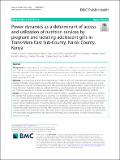| dc.contributor.author | Charles O Opiyo, David Omondi Okeyo, Sussy Gumo, Elly O Munde, Zablon O Omungo, Maureen Olyaro, Rachel K Ndirangu, Nanlop Ogbureke, Sophie Efange, Collins Ouma | |
| dc.description.abstract | Abstract
Background: During pregnancy or lactating, adequate nutrition for adolescents becomes critical to reduce risks for
both child and maternal-related morbidity and mortality. Power dynamics play a massive role in health outcomes.
The main objective of this study was to examine the power dynamics in the families and communities and their
impact on the pregnant and lactating adolescent girls’ access and utilization of nutrition services in Trans-Mara East
Sub-County, Narok County.
Methods: A cross-sectional approach that employed mixed methods with both quantitative and qualitative research was
adopted. Probability proportionate to size sampling techniques using cluster and simple random methods were used to
practically access pregnant or lactating adolescents. Data was collected using questionnaires, in-depth interview and Focus
Group Discussion. Quantitative data was analyzed descriptively using frequencies and inferentially using odds ratio and Ztest. Framework analysis was employed to analyze qualitative data. P ≤ 0.05 was considered statistically significant.
Results: In the power dynamics analyses, the intrinsic capability (Intrinsic capabilities are those adolescent driven initiatives
that facilitate their access to nutrition services) was more likely to decrease awareness by half (OR = 0.52, 95% CI = 0.4–0.7,
P < 0.01) whereas extrinsic dependency was likely to increase utilization by 1.2 times (OR = 1.2, 95% CI = 1.0–1.5, P = 0.055).
From the stakeholder power matrix, the health personnel had observable visible power to influence access and utilization of
nutrition services. Additional results revealed that adolescents who draw their support from significant others were more
likely to utilize nutrition services as compared to those who attempted to make their own efforts to seek these services.
Furthermore, health personnel have the most influential powers in ensuring adolescents access services and thus the most
important actors in the stakeholder matrix. Other actors requiring focus included parents, political figures and governments
while stakeholder engagement have higher potential of increasing access and utilization of services through dialogue.
(Continued on next page)
© The Author(s). 2020 Open Access This article is licensed under a Creative Commons Attribution 4.0 International License,
which permits use, sharing, adaptation, distribution and reproduction in any medium or format, as long as you give
appropriate credit to the original author(s) and the source, provide a link to the Creative Commons licence, and indicate if
changes were made. The images or other third party material in this article are included in the article's Creative Commons
licence, unless indicated otherwise in a credit line to the material. If material is not included in the article's Creative Commons
licence and your intended use is not permitted by statutory regulation or exceeds the permitted use, you will need to obtain
permission directly from the copyright holder. To view a copy of this licence, visit http://creativecommons.org/licenses/by/4.0/.
The Creative Commons Public Domain Dedication waiver (http://creativecommons.org/publicdomain/zero/1.0/) applies to the
data made available in this article, unless otherwise stated in a credit line to the data.
* Correspondence: collinouma@yahoo.com 4
School of Public Health and Community Development, Department of
Biomedical Science and Technology, Maseno University, Maseno, Kenya
Full list of author information is available at the end of the article
Opiyo et al. BMC Public Health (2020) 20:537
https://doi.org/10.1186/s12889-020-08690-w
Conclusions: Community access to nutritional services can be increased through use of multiple avenues to reach
adolescents, including school-based, health system-based, community-based approaches and even marriage registries. A
heightened engagement in the identified stakeholder network is necessary when planning community conversations, to
ensure a multi-stakeholder approaches in meeting the nutrition needs of adolescents.
Keywords: Power dynamics, Nutrition, Lactating, Pregnant, Adolescent | en_US |

